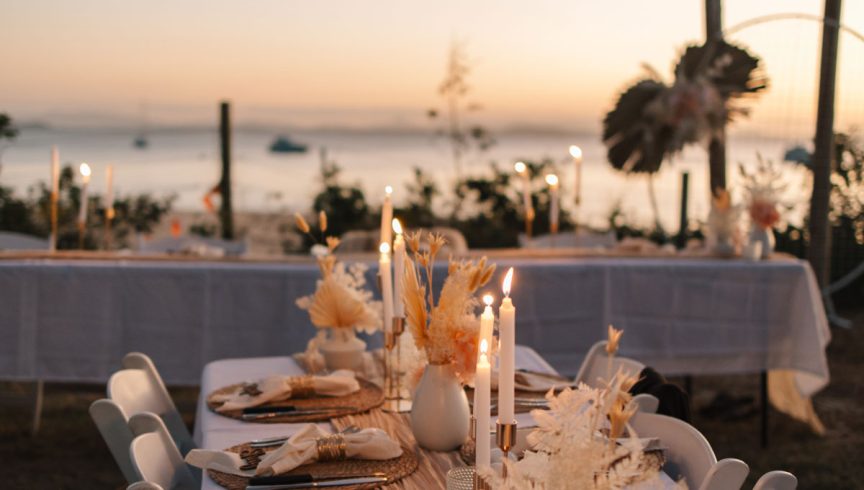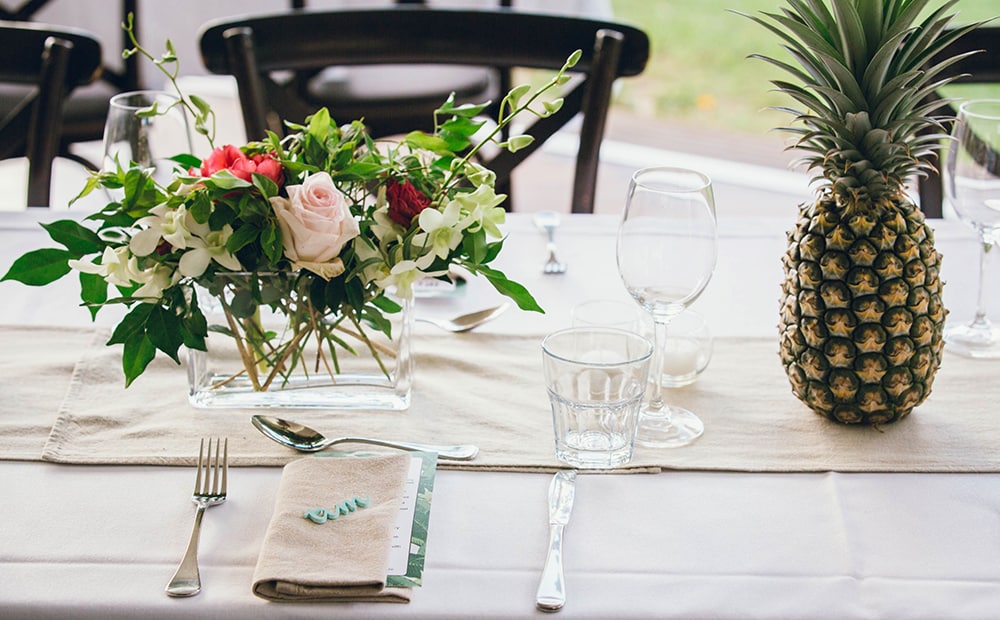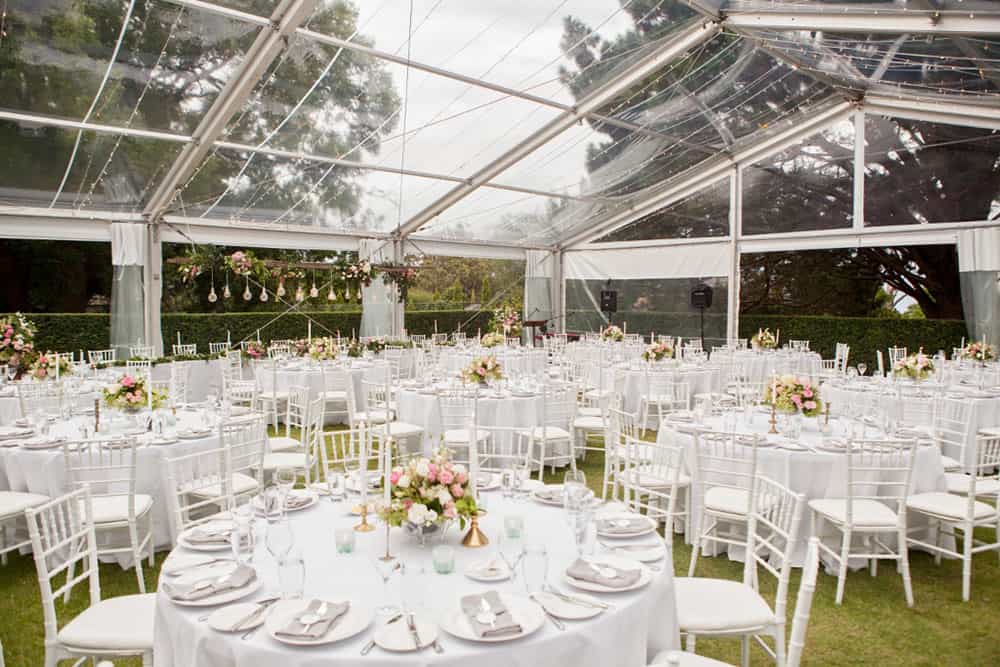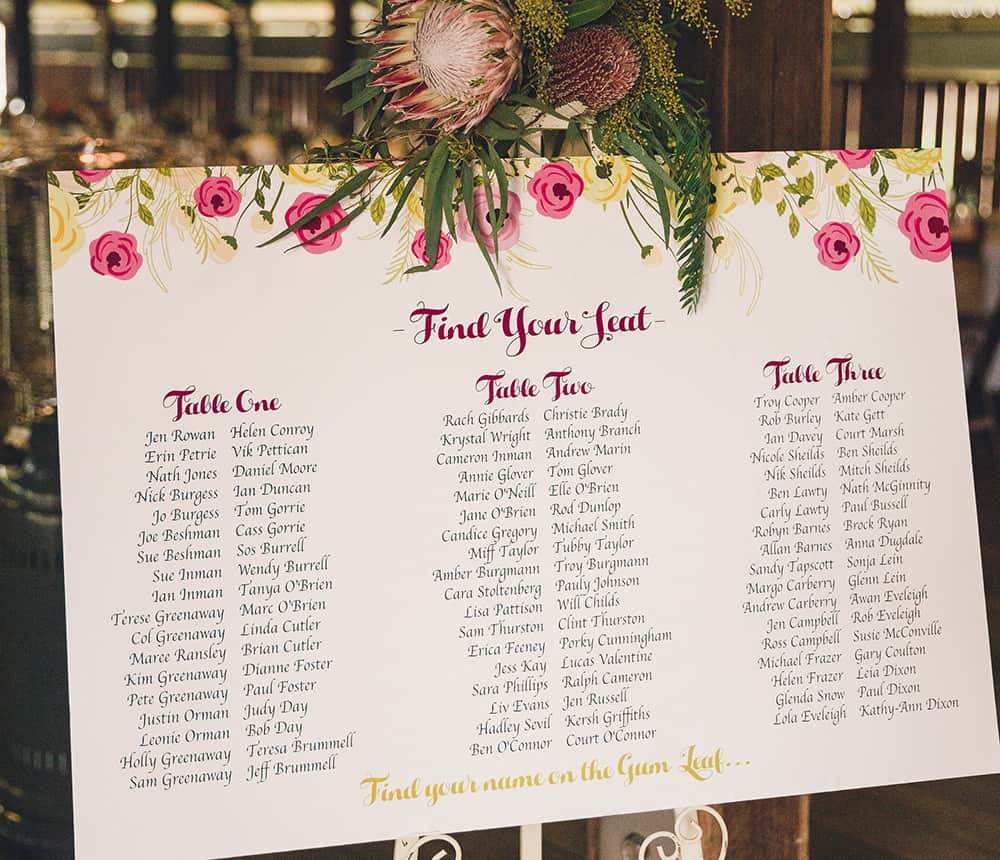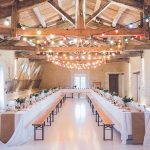You’ve planned the ceremony to a tee, figured out your entertainment and know your reception styling is going to be next-level stunning, yet you still can’t face how to organise the dreaded wedding seating plan.
Don’t worry, it’s an all-too-familiar point of stress for most couples at this stage of your wedding planning, inspired by clichéd ‘bridezilla’ scenes in countless rom-com movies. However, all jokes aside, getting bums on the right seats is something worth devoting time to.
From choosing the right tables, honouring the important people in your life, and working out who should sit where and with whom … here are our top tips for mastering your wedding seating plan
(feature image: Great Keppel Island reception)
Table Selection
Choosing what kind of tables to use at your reception is probably the most important decision you’ll make. It will not only determine the layout of your entire reception but will also influence the overall mood.
- Want to keep things chilled and conversational? Round tables are the way to go.
- If you prefer a more formal and sophisticated setting, long and rectangular tables are ideal, as they add a refined touch and have been a popular option for dinner parties for many years.
Your venue will most likely suggest a preferred option due to space or availability, but be sure to discuss your vision with them.
Space Considerations
It’s obvious a reception hasn’t been well planned when you’re getting elbowed by the person next to you trying to cut their steak.
Considering exactly how the room will be laid out should be second on your priority list and is something you’ll want to plan with your venue or wedding organiser
- For a 150cm round table…
Six chairs will feel a little too roomy, while eight will allow guests plenty of elbow room and space for pulling their chairs in all the way. - If opting for standard 15cm by 75cm rectangular tables…
Six or eight chairs are again the better option, depending on whether you use the ends of the tables.
Don’t forget also to keep the space between each table in mind so guests are able to move around with ease – especially if you’re accommodating wheelchair access.
- The general rule of thumb…
Allow for 60 inches between tables, leaving plenty of room for guests to pull out their chairs and for servers to do their job.
Guests of Honor
Okay, so you’ve planned out where everyone else is going to sit, but what about the seating of the wedding party?
One of the commonly used seating arrangements is the traditional head table, which is typically placed in the front and centre. However, there are several alternative methods for seating the special guests.
- The Inimate Table
A ‘sweetheart table’ can be as lovely as the name suggests. Instead of sitting with the wedding party, this option allows couples to enjoy the celebrations from their own small table. Intimate and romantic, it’s a great way to relax and take in the moment with your new hubby – something you just might be thankful for after a whirlwind day of pre-wedding prepping and, you know, actually getting married. - Reserved Seating
For something a bit more sociable, don’t be afraid to get a little creative. It’s not for everyone, but including two spare seats at each table for the bride and groom to mingle can be a fun way to enjoy the reception. Unless you want to look like you’re playing musical chairs, stay at one table for each course and don’t stress too much if you don’t get to every table by the end of the reception. - The Traditional Head Table
Of course, there’s a lot to love about the classic head table. You’ll not only get the best view of the festivities but getting the chance to hang out with your wedding party is something traditionalists will treasure forever. This is the standard option for most venues, reducing any extra planning stress.
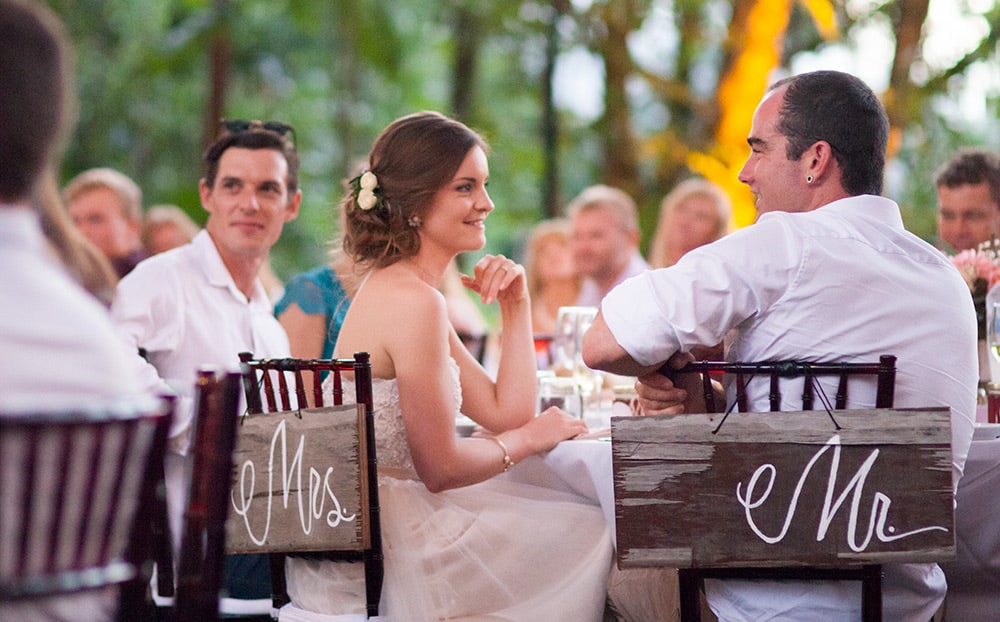
From the wedding of Sophie & Clint
Places Please
Once you’ve sorted out the actual layout, it’s time to decide how you’re going to display everyone’s places.
Don’t know the difference between place and escort cards? Not familiar with seating charts? Let’s break it down now.
- Place cards
Place cards are a more formal option, telling guests exactly which seat is theirs at a table. They’ll typically be found at each guest’s place at their respective tables and are a great way to tag bonbonniere. - Escort cards
The babies only include guests’ table assignments. This allows them a little more freedom in deciding exactly where to sit – and perhaps more importantly – who to sit next to. - Seating charts
Not unlike escort cards, seating charts serve the same purpose but involve displaying every guest’s place on a large sign. A somewhat eco-friendly and cost-effective option, they’re arguably the most popular option.
Bonus tip – if you’re looking for a unique way to display your guests’ seating arrangements, why not name your tables after favourite songs or memorable dates? That concert you went to together, the first place you had dinner, where you got engaged – they’re all sweet ideas that’ll bring up beautiful memories.
A few go-to tips
- We’re all friends here…
The obvious tip of the day is to try to avoid seating people who don’t get along next to each other. If your parents are divorced or separated, assigning them their own table, with maybe a few family friends or relatives, is a nice idea. - Matchmaker …
Also, you might think it’s a clever idea to play matchmaker and seat a table of singles together, but try to resist it if you can. Forcing a group of singles together can be awkward for everyone, and it’ll leave them muttering under their breath, “well, that wasn’t very subtle.” - The kids are alright…
Seating children at your wedding can present another set of challenges. Kids’ tables can be a very good idea if there’s a sizeable group of littlies, but be sure to keep a responsible adult seated at the next table. It’s also a fantastic idea to set up a small ‘kids only’ area with a colouring-in station, board games, books and – depending on your budget – kid-friendly entertainment. Bye-bye, temper tantrums!
How to Make Your Seating Chart
Not sure where to start? There’s a long list of ways to plan your seating layout…
- ALLSEATED
Of course, there’s an app for that! Free to use, AllSeated is a digital platform that helps you set out your reception floor plan and visualise it in 3D. allseated.com - EXCEL
Chances are you’ve probably got a wedding spreadsheet on the go. It’s a simple tip, but adding an extra page with a column for each table and names underneath is a fuss-free way to keep all your plans together. Or download this fabulous colour coded Excel seating chart from Style Me Pretty. - GOOD OL’ PEN AND PAPER
It’s an old-fashioned idea, but hey, it still works. Write all your guests’ names on a sticky note tab and place them on their corresponding table – an A4 sheet of paper with the table number listed. Once you’re happy with your arrangement, don’t forget to take a photo to refer to when you’re planning with vendors.
Time to find a venue! Check out our great local receptions directory here.

